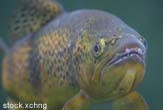Non-Native Fish Invade Western Streams

A quarter of all fish in streams of 12 western states are non-native, according to the U.S. Geological Survey.
The aquatic invasion is widespread. Half of all streams in the West are home to non-native fish. Few habitat types are immune, and humans are largely to blame.
One of the most surprising conclusions in the new study: In streams that are among the most pristine, there are generally more non-native fish than native.
All habitats
"Non-native fishes were found across the landscape in all habitat types, though streams in forested areas were less likely to contain non-native fish," said Scott Bonar, a USGS researcher at the University of Arizona. "Our data suggest that no matter how pristine the habitat type, there exists a non-native species that can colonize it."
Other findings:
- In about 11 percent of streams, all fish were non-native.
- Non-native fish were most common in streams of the interior states of Arizona, Colorado, Nevada, Utah, and Montana.
- In Colorado, two of every three fish are non-native (in North Dakota, only 1 in 12 is non-native).
The survey covered 400,000 miles of streams in Arizona, California, Colorado, Idaho, Montana, Nevada, North Dakota, Oregon, South Dakota, Utah, Washington and Wyoming.
Get the world’s most fascinating discoveries delivered straight to your inbox.
Why it matters
Scientists with the U.S. Fish and Wildlife Service say about 40 percent of all freshwater fish species in the country are at risk of extinction. Non-native fish can take over spawning grounds and crowd the natives out.
The invaders might not sound so foreign, however.
The most common non-native species include brook, brown, cutthroat and rainbow trout, as well as smallmouth and largemouth bass that were introduced here and there for sport. Other fish were added to streams on purpose to combat mosquitoes or to be food for larger fish.
The study, announced this week and published in the North American Journal of Fisheries Management in November, raises an unexpected possibility.
"Without deemphasizing the importance of landscape disturbance by humans, we concluded that non-native fishes pose an equivalent, if not greater, threat to native fishes than habitat degradation in western U.S. streams," Bonar said. "Consequently, attention to both habitat degradation and the non-native species problem is important to effectively restore streams of the American West."
Last week, federal officials announced that Fish and Wildlife, USGS, NOAA, state agencies, sport-fishing and conservation groups have partnered to work on fish habitat restoration plans. The idea is to protect healthy habitats and improve 90 percent of others by 2020.
- GALLERY: Invasive Species
- Jellyfish Invade the Globe, Thanks to Humans
- Oops! Scientists Nudge Fish Closer to Extinction
- Invasive Creatures Attack Like Internet Viruses
- Five Deep-Sea Fish on Brink of Extinction
- Controlling Invasive Plants
Robert is an independent health and science journalist and writer based in Phoenix, Arizona. He is a former editor-in-chief of Live Science with over 20 years of experience as a reporter and editor. He has worked on websites such as Space.com and Tom's Guide, and is a contributor on Medium, covering how we age and how to optimize the mind and body through time. He has a journalism degree from Humboldt State University in California.



